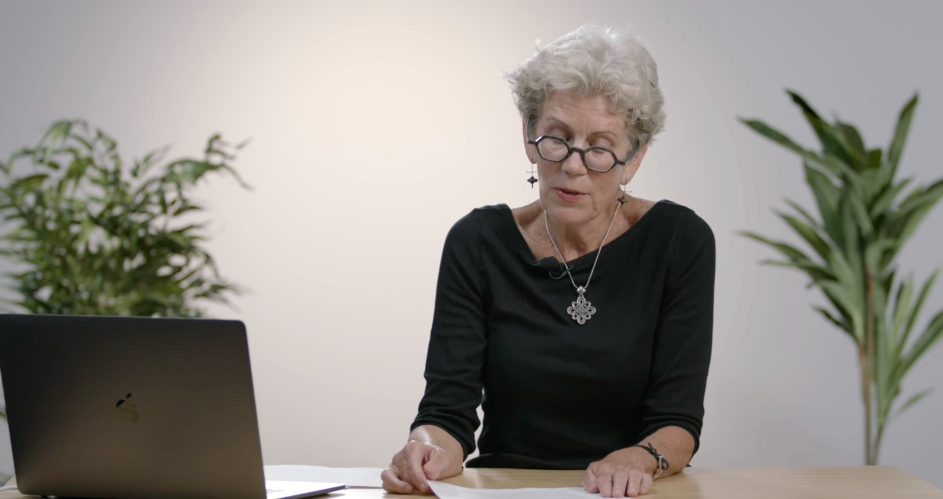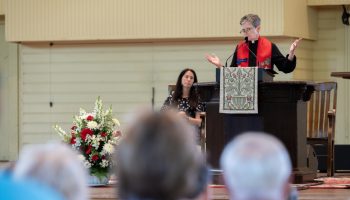
Judy Beals’ favorite quote from former Secretary of State Madeleine Albright is also an antithesis to Beals’ pitch for injecting religion into cultural context.
“Diplomats in my era were taught not to invite trouble, and no subject seemed more inherently treacherous than religion,” Albright said.
But Beals brought up several case studies that she said indicated a need for expanded interfaith religious education: the U.S. government’s lack of understanding of Islam spurred the post-9/11 invasion of Iraq; the international community failed to understand the significance of burial practices in West Africa, which caused an isolated Ebola virus to go global; and most Americans learn about religion not from courses, but from movies and TV shows.
“We need to teach religion in schools, but not in the way you think,” Beals said.
Beals proposed teaching religion along with nuanced cultural context in her lecture, “Teaching Religion Through New Eyes,” at 2 p.m. EDT Monday, Aug. 3.
Beals’ lecture launched Week Six of the Interfaith Lecture Series theme, “Lessons in the School House.” Chautauquans submitted questions during the livestream on the CHQ Assembly Video Platform, through the www.questions.chq.org portal or on Twitter with #CHQ2020. Vice President for Religion and Senior Pastor Gene Robinson joined Beals to deliver questions in a subsequent Q-and-A.
Beals is an associate director for Harvard’s Religious Literacy Project and is also an experienced human and civil rights attorney, former legislative aide in the U.S. Senate, a former state Assistant Attorney General and a nonprofit CEO.
Mainstream religion courses teach religions as if they are unchanging since inception, Beals said. While learning the basic doctrines, rituals, myths and symbols is still necessary — 66% of Americans in a study knew that the first book in the Bible was the Book of Genesis, but much less that the Dalai Lama was a Buddhist figure — religious education needs to touch on how religions affected past and present events.
“How does learning about the five pillars of Islam teach us about the resurgence of the Taliban in Afghanistan?” Beals said. “The limitations of this are even more apparent when considering history. How can we know anything about Christian attitudes about the Crusades, the Inquisition or Christian support for chattel slavery?”
Beals said along with the negative effects of religion in history, there are also believers that use the same set of values for good.
“Though some Buddhists in Myanmar are involved in the persecution of Rohingya Muslims, others — based on their own Buddhist values and convictions — are opposing those actions,” Beals said. “And while it’s true that Evangelical Christians supported Donald Trump, others did not, including other white Christian Evangelicals. And similarly, many Muslims in Afghanistan and around the world oppose the Taliban. Understanding the diverse reasons of each of these actions is what is really important.”
Teaching religion with a non-devotional approach, which Harvard’s Religious Literacy Project proposes and provides resources for, observes multiple competing perspectives in religions without one superseding the other in importance.
One theme in this curriculum is that religions are not uniform and “internally diverse,” with a center mainstream and believers on the margins.
“Religion is a lived thing,” Beals said. “It is practiced as it is understood and adhered to by its adherents and its followers. And that means it is always changing and evolving. So two communities within the same branch may practice their religion very differently.”
A Catholic Mass in rural Uganda will differ from a Catholic Mass in France, as it would be different in the Philippines or in Latin America, Beals said. In Islam, women in some cultures are not required to wear a veil. Jewish kosher practice can be interpreted in multiple ways.
“Think about how often one hears things like, ‘Buddhists are nonviolent,’ or, ‘Islam promotes terrorism’ or, ‘Christians are socially conservative,’” Beals said. “These kinds of statements, no matter how well-meaning, are always over-broad and they are incorrect. It is too simplistic to capture the rich diversity of religious expression, and it is always something to stop when you hear it.”
Religions also change in response to historical and social conditions based on new opportunities, constraints and challenges framing those religions. While some religions claim to be unchanging over time for the sake of performing authenticity, Beals said that no person or institution remains static over time.
And it doesn’t end after a Mass, Shabbat or meditation concludes. It leaks into how nations shape their calendar and how companies grant holidays from work, as well as art, architecture, food and language. Even the U.S. justice system doesn’t go unscathed, Beals said, as it has direct ties to Calvinist ethics.
“For the practicing and the non-practicing alike, religious stories and allegories — think of the Good Samaritan, the golden rule, Mara and the Buddha, so many others — these are powerful influences of how people respond to adversity in their lives,” Beals said.
COVID-19, Beals said, is one such example of people looking to faith institutions for guidance. Some churches are operating as health care sites while others have become “super spreaders” for the virus.
“We see a range of responses from faith communities to public health advice around public gatherings and so on. And we see that evolving and changing all of the time,” Beals said. “And frankly, I think religious services and practices will be forever changed by the coronavirus.”
Beals said that religious education should shed light on how religion is a nuanced influence on past and present moral justifications.
“Clearly throughout history and ongoing, religion has functioned to inspire and justify a range of human action, from the heinous to the heroic,” Beals said.
Done right, she said, religious literacy can also help students imagine a more just future and understand the world with religious context. One project where students came up with their own case studies included how Muslim women engage with New York Fashion Week and how Muslim astronauts pray toward Mecca while in space.
“It means they get to ask and are expected to ask the religion question anywhere,” Beals said. “They cannot assume religion is irrelevant to any situation.”




